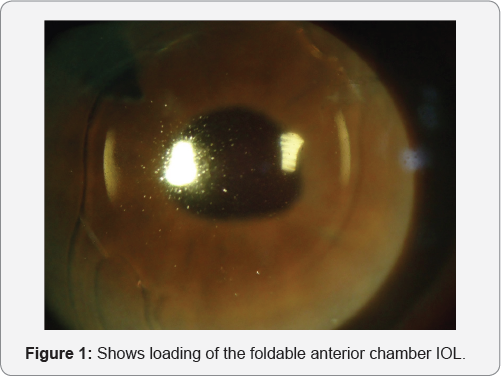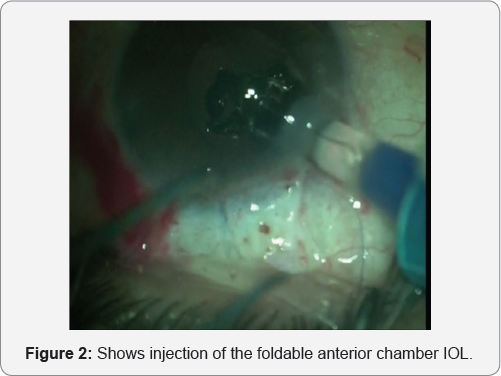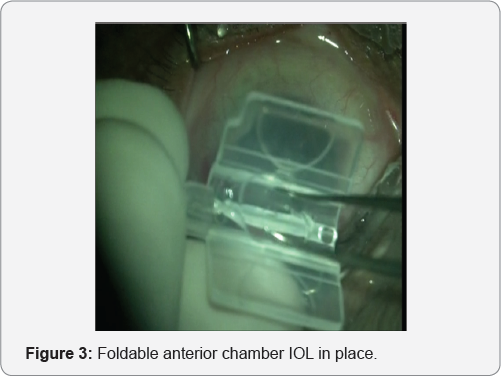JUNIPER
PUBLISHERS- JOJ Ophthalmology
Abstract
Purpose: To assess the outcomes of anterior chamber foldable intraocular lens (IOL) for aphakia correction.
Materials and methods: Retrospective
non-comparative case series study for patients who underwent an
operation for aphakia correction by the means of injection of an angular
supported foldable IOL performed for 20 eyes of 15 patients. Student’s
paired t-test was carried out to compare pre-operative and
post-operative visual acuity (VA), IOP & corneal endothelial cell
count.
Results: 15 patients were included in the
study; 12 males & 3 females. Mean age was 55.38±17.67 years. Mean
follow-up duration was 5.95±3.14 months. The mean log MAR visual acuity
was 1.26±0.46 pre-operatively and 0.78±0.57 post-operatively (P =
0.003). The change in IOP and corneal endothelial cell count were not
statistically significant.
Conclusion: Injection of angular support foldable IOL in the AC is a useful technique for the correction of aphakia.
Introduction
Posterior capsular rupture is a well-known intra-operative complication of cataract surgery [1].
In complicated cases with insufficient capsule and lost zonular support
it is not possible to insert a posterior chamber intraocular lens (PC
IOL) [2].
Several techniques including posterior chamber sclera fixed lens,
anterior chamber sulcus supported lens and anterior chamber iris claw
lens have been reported to result in good visual out¬come in the
management of aphakic eyes without capsular support [3].
The polymethylmetacrylate (PMMA) ante¬rior chamber (AC) intraocular
lens has long been considered as a standard method of aphakia
correction. This has been linked to various complications includ¬ing
bullous keratopathy, increase of intra ocular pres¬sure (IOP), and
endothelial cell loss or even visual loss [4].
Technological advances in lens design (angular support) and in lens
mate¬rial (acrylic) have permitted the safe use of lens in the anterior
chamber for refractive error correction [4,5].
The aim of the current study was to determine the
outcome of using the anterior chamber (AC) foldable lens for unilateral
aphakia.
Material and Methods
This is a retrospective non-comparative, consecutive
case series study, in which 20 eyes of 15 patients underwent an
operation for aphakia correction by the means of injection of angular
support foldable intraocular lens in the anterior chamber between
January 2014 and December 2014 in Dar El Ouyon Hospital. Written
informed consent was obtained after explaining the nature of the
procedure from all patients before surgery. Preoperatively, each patient
underwent a detailed ocular history (indicating the cause of aphakia)
and a standard eye examination including testing of uncorrected and best
corrected distance visual acuity (BCVA) using Snellen visual acuity
chart (converted into log MAR units for statistical purposes),
measurement of the intra ocular pressure (IOP) by Goldmann applanation
tonometer, slit lamp examination focusing on the corneal details, and
gonioscopy, fundus, and retinal periphery examination. Biometry,
anterior chamber depth and corneal White-to-White (WTW) diameter were
measured using the IOL Master 500 (Carl Zeiss Meditec AG). Specular
microscopy was done to reveal endothelial cell count and abnormal forms
using inclusion criteria were unilateral or bilateral aphakia with no
capsular support or clinical keratopathy, no evidence of glaucoma, open
irido corneal angle, AC depth > 3 mm, WTW diameter > 11.5 mm, and
improvement of the visual acuity with corrective trial lenses.
Patients with clinical keratopathy, glaucoma,
uveitis, peripheral anterior synechia or clinical maculopathy were
excluded. All surgeries were conducted under local peri-bulbar
anesthesia using Bupivacaine 0.5% + Xylocaine 2%. One 1-mm paracentesis
was made at the upper nasal position and one 2.80 mm clear corneal
tunnel incision was made at the upper temporal position with the
keratome. A viscoelastic (Viscoat, Alcon) substance was used to reform
the AC. The foldable single piece acrylic intraocular lens with the
angular support was then injected gently in the anterior chamber, (Figure 1&2).
A peripheral iridectomy was done using Vanas scissors. The viscoelastic
substance was removed from the anterior chamber with the Simcoe
cannula. At the end of the procedure, a subconjonctival depot of
dexamethazone and gentamicin was given.


Follow-up visits were scheduled as follows: one day,
one week, two months, six months, and one year following surgery. At
each follow-up visit, BCVA and IOP were assessed and corneal endothelial
cell count and morphology were analyzed. Figure (3)
shows foldable anterior chamber IOL in place. Student’s paired t-test
was carried out to compare post-operative and pre-operative visual
acuity (VA) and intraocular pressure (IOP). The analysis was performed
using statistical software Epi-Info 7 and IBM SPSS 19. P-values less
than 0.05 were considered statistically significant.

Results
Twenty (20) eyes of fifteen (15) patients were
included in this study. The demographics and baseline eye
characteristics for all patients are presented in . Eight patients were
males (10 eyes, 50%) and seven were females (10 eyes, 50%). Mean age was
50.75 ± 11.275 years (range 30-72 years). Aphakia causes included: 2
planed ICCE (10%), 6 inadvertent posterior capsule rupture with vitreous
lost during planed phacoemulsification (30%) and 12 post-traumatic lens
subluxation (60%). The mean follow-up duration was (10.8 ± 2.02) months
(range 6-12 months). Sixteen (80%) patients showed improvement of the
post-operative BCVA of one line or more; two (10%) showed no improvement
and two (10%) patients showed deterioration in their post-operative
BCVA. The mean visual acuity in log MAR was (1.14 ± 0.46) pre-operative
and (0.605 ± 0.489) post-operative (P < 0.05). Post-operative
complications are presented in. Two patients (10%) had post-operative
intraocular hypertension (over 21 mmHg). Two (20%) patients had pupil
distortion, one patient (10%) had retinal detachment and one (10%)
patient had macular edema. No corneal problem requiring lens removal was
registered.
Discussion
There are many options for management of aphakia with no capsular support [5].
Anterior chamber IOL is one of these options. Foldable lenses with
angular support are currently used in the anterior chamber for
refractive error correction [6].
In this study, we injected a foldable lens with angular support in the
anterior chamber to correct the aphakia. All patients presented with
aphakia without capsular support from various etiologies. Post-traumatic
lens subluxation was the leading cause of aphakia (60%) in our study.
Sixteen (80%) patients showed significant improvement of the BCVA from
(1.14 ± 0.46) pre-operative to (0.605 ± 0.489) post-operative (P <
0.05). Previous studies using an iris claw lens to correct aphakia
reported significant VA improvement and a low rate of complications [5,7].
However, despite the good visual outcome, implementation of iris claw
techniques requires specialized equipment and a long training period.
The insertion of a foldable lens in anterior chamber is a very easy
procedure through a 2.80 - 3 mm clear corneal tunnel.
In our study, 2 eyes (10%) developed of post
operatively a transient IOP elevation, which was managed with
topical medications. This change in IOP was not statistically
significant (P=0.32). It was also reported in other similar
studies [1-3]
in which other approaches were used to correct aphakia. Two
cases (10%) with pupil distortion were observed postoperative,
which was also noted, in another study (2). One case (5%) developed
macular edema post-operative, which resolved on topical steroids and
non-steroidal anti-inflammatory drops. One case (5%) developed
post-operative retinal detachment. A vitrectomy and silicone oil
injection was done. These two complications resulted in lower VA in
our study.
Conclusion
Our results showed that foldable IOL injection in the
anterior chamber improved visual acuity; the complications were similar
to those reported in the literature using other methods. Although the
visual outcome was good for most patients in this series, more extended
follow up and a large series of patients are needed to ascertain the
effectiveness and safety of this procedure.
What was Known
Rigid anterior chamber IOLs were commonly used for
visual rehabilitation in cases of aphakia. This was associated with many
complications such as elevated intraocular pressure, anterior uveitis
and corneal decompensation.
What this Paper Adds
Using foldable anterior chamber IOL provides easy, safe and effective method for correction of aphakia.
For more articles in JOJ Ophthalmology (JOJO) please click on: https://juniperpublishers.com/jojo/index.php
No comments:
Post a Comment